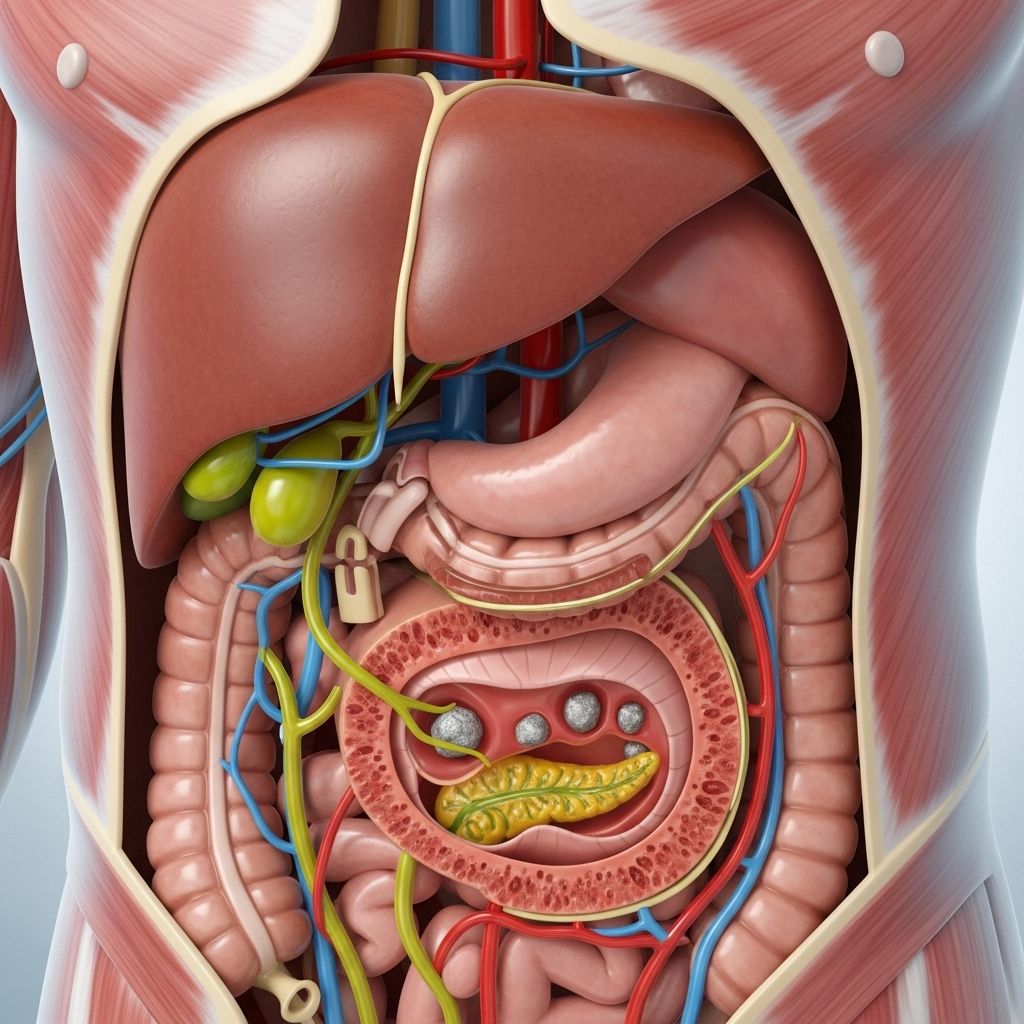What Causes a Gallbladder Attack?
An in-depth guide to gallbladder attacks, their causes, symptoms, risks, and treatments, including what you can do to prevent complications.

The gallbladder is a pear-shaped organ located beneath your liver, with the critical job of storing and concentrating bile produced by the liver. This bile aids in the digestion of fats. While the gallbladder performs an essential function, it can sometimes become problematic, particularly when gallstones or other conditions interfere with the normal flow of bile. The result? A painful event known as a gallbladder attack. This guide examines the causes behind such attacks, associated symptoms, risk factors, complications, treatments, and answers to frequently asked questions.
Understanding the Gallbladder and Its Function
The gallbladder’s main purpose is to serve as a reservoir for bile, a digestive fluid produced continuously by the liver. During meals—especially those high in fat—the gallbladder contracts, releasing stored bile into the small intestine via the bile ducts. Here, bile helps emulsify fats, facilitating efficient digestion and absorption.
- Location: Upper right abdomen, beneath the liver.
- Shape and Size: Pear-shaped; about 3-4 inches long in adults.
- Function: Stores and concentrates bile, releases bile in response to signals prompted by fatty foods.
A gallbladder attack, often referred to as biliary colic or acute cholecystitis, occurs when the flow of bile is blocked, most commonly by gallstones. This blockage leads to sudden and severe pain in the upper right abdomen. While gallstones are the leading cause, several other conditions may contribute to or trigger a gallbladder attack.
Gallstones: The Primary Culprit
Gallstones are hardened deposits of digestive fluid that can vary in size from a grain of sand to a golf ball. They form when:
- There is an excess of cholesterol in bile.
- There is an excess of bilirubin, a chemical produced from the breakdown of red blood cells.
- The gallbladder is unable to empty itself effectively, allowing bile to become excessively concentrated.
When a gallstone lodges in the cystic duct or common bile duct, it blocks the flow of bile, resulting in increased pressure, inflammation, and pain.
Other Causes of Gallbladder Attacks
- Bile Sludge: Sometimes, thickened bile (sludge) without actual stones can block the ducts.
- Biliary Tract Infection: Bacterial infections can inflame the gallbladder and ducts.
- Tumors: Rarely, cancerous or noncancerous tumors may physically obstruct bile flow.
- Narrowed Bile Ducts: Inflammatory conditions, previous surgery, or scarring can cause narrowing and subsequent blockages.
Risk Factors for Gallbladder Attacks
Some individuals are more likely to develop gallstones and consequently gallbladder attacks. Notable risk factors include:
| Risk Factor | Details |
|---|---|
| Age | Risk increases as you get older, especially over 40. |
| Gender | Women are more prone, due to hormonal influences—especially those who are pregnant, use hormone therapy, or take birth control pills. |
| Obesity | Extra weight increases cholesterol in bile and slows gallbladder emptying. |
| Diet | High-fat and high-cholesterol diets, or rapid weight loss, can contribute. |
| Family History | Genetics play a role; attacks may run in families. |
| Other Medical Conditions | Diabetes, liver disease, metabolic syndrome, or certain blood disorders increase risk. |
Symptoms of a Gallbladder Attack
A gallbladder attack is typically characterized by sudden, severe abdominal pain. The pain and its associated symptoms can present in various ways:
- Intense pain in the upper right or center of the abdomen, sometimes radiating to the back between the shoulder blades or to the right shoulder.
- Pain that can last from a few minutes to several hours, sometimes described as dull, cramping, sharp, or constant.
- Nausea and vomiting, especially after eating fatty or heavy meals.
- Fever and chills, which may suggest gallbladder inflammation or infection.
- Jaundice, a yellowing of the skin and whites of the eyes, suggesting a blockage affecting the liver.
- Dark urine or light-colored stools caused by lack of bile reaching the intestines.
- Abdominal tenderness upon touch or pressure.
While pain is the hallmark symptom, not everyone experiences it in the same way. Some episodes are mild and intermittent, while others require emergency medical attention.
Complications of Gallbladder Attacks
Timely medical evaluation is critical. Without it, a gallbladder attack can progress to severe and potentially life-threatening complications:
- Acute Cholecystitis: Inflammation and infection of the gallbladder. Requires prompt treatment, often with antibiotics and possibly surgery.
- Pancreatitis: If a gallstone blocks the pancreatic duct, it can inflame the pancreas, leading to pain and digestive difficulties.
- Cholangitis: Infection of the bile ducts that can spread rapidly and cause sepsis.
- Gallbladder Rupture: Rare but extremely serious, can lead to peritonitis (infection of the abdominal lining).
- Blocked Intestines: If a gallstone escapes to the small intestine, it may cause a bowel obstruction.
Diagnosing Gallbladder Attacks
If you or your healthcare provider suspects a gallbladder attack, several diagnostic approaches may be used to confirm the cause and determine the extent of the problem:
- Physical Examination: Your doctor will check for abdominal tenderness and signs of jaundice.
- Blood Tests: Check for elevated white blood cell counts (infection) and liver function abnormalities.
- Ultrasound: The most common and efficient way to detect gallstones and inflammation.
- CT Scan: May be performed for more detailed imaging.
- HIDA Scan: Tracks the flow of bile and can reveal blockages or abnormal gallbladder function.
- MRCP (Magnetic Resonance Cholangiopancreatography): For noninvasive visualization of bile and pancreatic ducts.
Treatment Options for Gallbladder Attacks
Treatment depends on the cause, severity, and whether complications have arisen. Main approaches include:
Initial Management
- Pain Management: Analgesics (such as NSAIDs or stronger narcotics) for acute pain relief.
- Fasting: Temporarily refraining from eating or drinking to “rest” the gallbladder.
- Intravenous Fluids: To maintain hydration if oral intake is not possible.
- Antiemetic Medications: For relief from nausea and vomiting.
- Antibiotics: Given if infection is suspected or confirmed.
Definitive Treatments
- Cholecystectomy (Gallbladder Removal): Most common and effective treatment, especially following acute attacks or with recurrent gallstones. Usually performed via minimally invasive laparoscopic surgery.
- Nonsurgical Management: Rarely, medications such as ursodeoxycholic acid can dissolve certain small cholesterol stones, but this method is slow and stones may recur.
- Endoscopic Procedures: Endoscopic retrograde cholangiopancreatography (ERCP) may be needed to extract stones from ducts.
Note: Healthy individuals can usually live normally without a gallbladder, as the liver continues to produce bile directly into the intestines.
Can You Prevent a Gallbladder Attack?
While some risk factors—like age and genetics—cannot be changed, you can take proactive steps to reduce your risk:
- Maintain a healthy body weight. Avoid rapid weight loss; lose weight gradually if needed.
- Follow a balanced diet rich in fiber, fruits, vegetables, and whole grains. Limit saturated fats and cholesterol-heavy foods.
- Exercise regularly to help maintain healthy digestion and metabolism.
- If you are at high risk, discuss preventive strategies with your doctor. Some people with silent gallstones may require watchful waiting or elective cholecystectomy before symptoms arise.
Life After Gallbladder Removal
Many people worry about digestion after cholecystectomy (gallbladder removal), but most lead a normal life. Some experience mild digestive changes, such as:
- Bloating or diarrhea, particularly after high-fat meals.
- Urgency with bowel movements immediately following fatty foods.
These symptoms usually improve over time, as the digestive system adapts. Your doctor may recommend dietary modifications temporarily post-surgery.
Frequently Asked Questions (FAQs)
Q: What does a gallbladder attack feel like?
A: It typically presents as a sudden, severe pain in the upper right abdomen or middle of the stomach, often after fatty meals. The pain can last several minutes to hours and may radiate to the back or right shoulder. Associated symptoms may include nausea, vomiting, fever, and—in some cases—jaundice.
Q: What should I do if I suspect a gallbladder attack?
A: Seek prompt medical attention if you experience intense abdominal pain, especially with fever, persistent vomiting, or jaundice. Some symptoms could signal a serious infection or complications requiring emergency treatment.
Q: How is a gallbladder attack diagnosed?
A: Diagnosis starts with a physical examination and blood tests, and is often confirmed with imaging such as an ultrasound, CT scan, HIDA scan, or MRCP to detect gallstones, blockages, or inflammation.
Q: Can gallstones pass on their own?
A: Sometimes small gallstones pass without causing ongoing problems, but persistent symptoms or large stones usually require intervention to prevent recurrence or severe complications.
Q: Is gallbladder removal always necessary?
A: Not always, but it is considered the definitive solution for repeated or complicated gallbladder attacks. Some patients with mild cases may benefit from nonsurgical management, under a physician’s supervision.
When to Seek Emergency Medical Attention
- Severe or worsening abdominal pain lasting more than a few hours
- Pain accompanied by fever or chills
- Jaundice (yellowing of the skin or eyes)
- Confusion, rapid heartbeat, or severe nausea/vomiting
These could be signs of serious infections, gallbladder rupture, or acute pancreatitis—conditions that can be life-threatening without immediate treatment.
Key Takeaways
- Gallstones are the primary cause of gallbladder attacks.
- Symptoms include sudden, severe pain in the upper right abdomen, nausea, vomiting, and occasionally jaundice.
- Risk factors involve age, sex, obesity, family history, and certain medical conditions.
- Prompt diagnosis and treatment are essential to avoid complications.
- Gallbladder removal is a common and effective treatment for recurrent attacks or complications.
- Healthy lifestyle choices can help reduce your risk.
References
- https://www.wakehealth.edu/condition/g/gallbladder-disease
- https://www.healthline.com/health/gallbladder-attack
- https://www.nhs.uk/conditions/acute-cholecystitis/
- https://my.clevelandclinic.org/health/symptoms/23355-gallbladder-pain
- https://my.clevelandclinic.org/health/diseases/22976-gallbladder-disease
- https://healthcare.utah.edu/general-surgery/gallbladder
- https://www.mayoclinic.org/diseases-conditions/gallstones/symptoms-causes/syc-20354214
- https://hje.org.uk/blog/are-you-having-a-gallbladder-attack-find-out-more-about-the-causes-symptoms-and-treatment/
- https://www.mayoclinic.org/diseases-conditions/gallstones/diagnosis-treatment/drc-20354220
Read full bio of Sneha Tete












